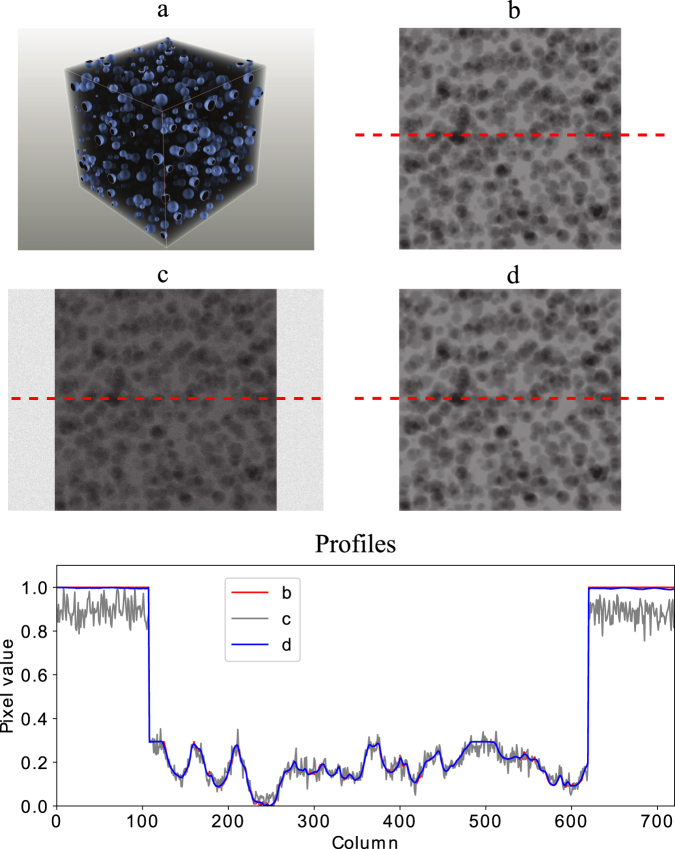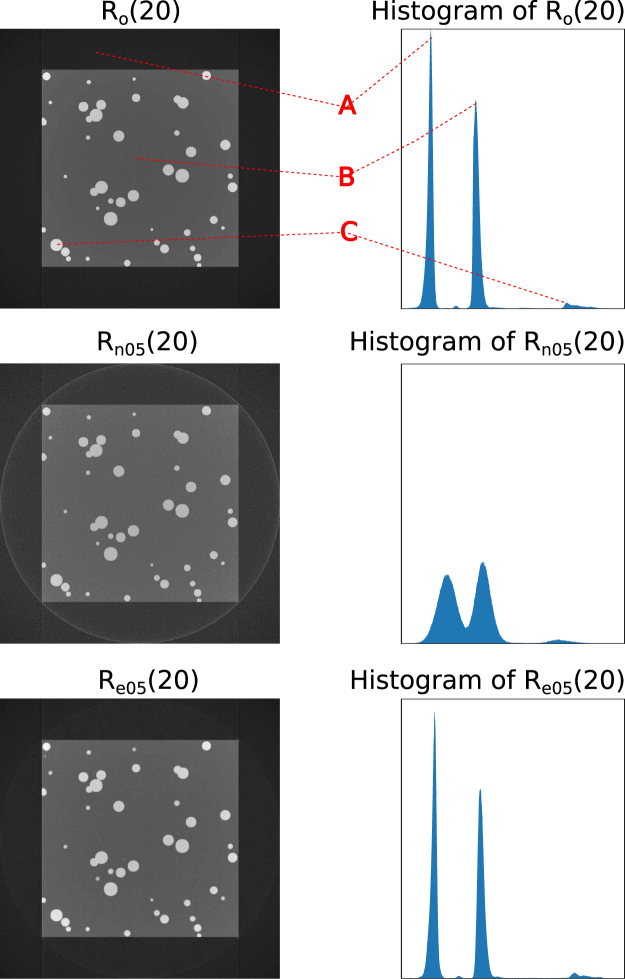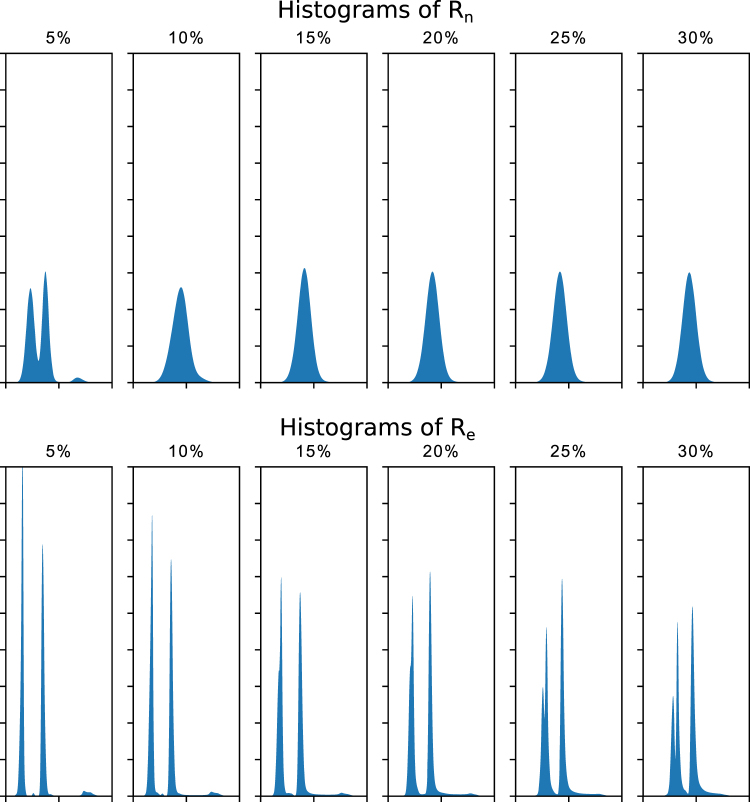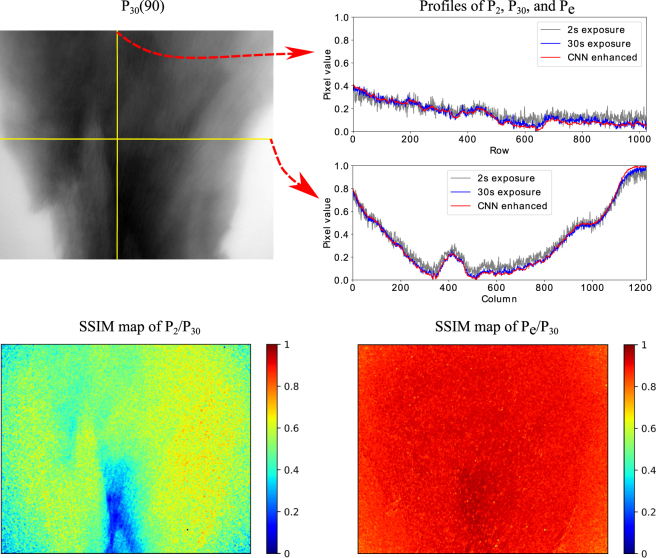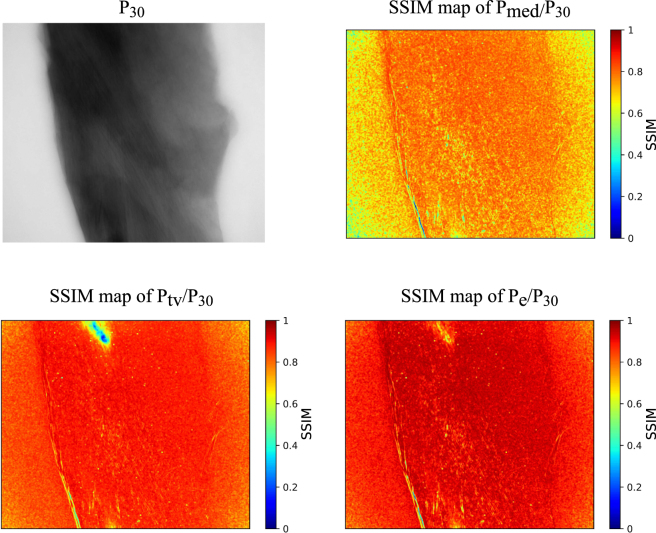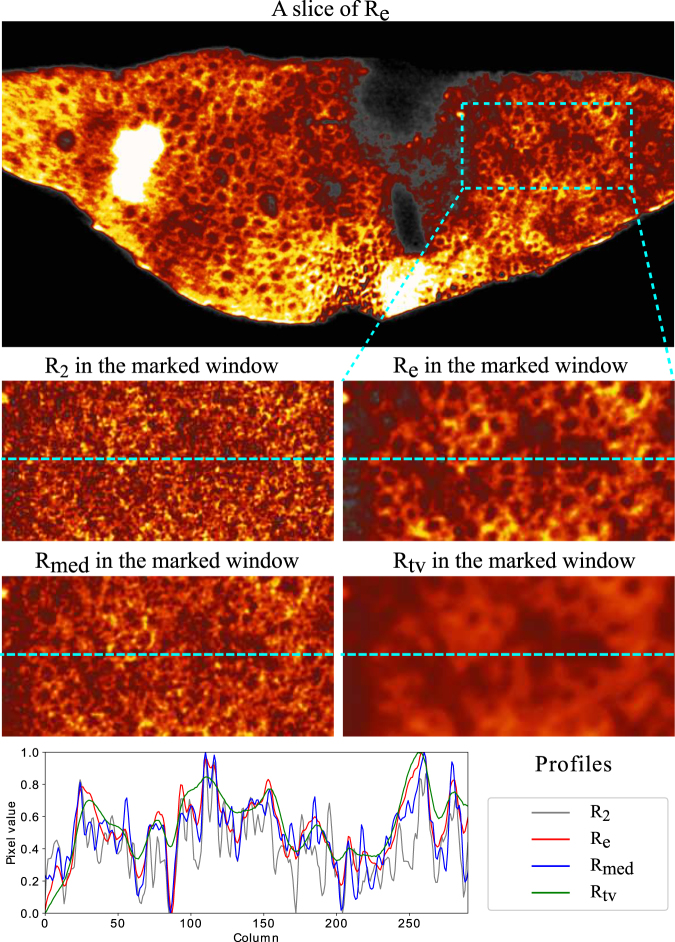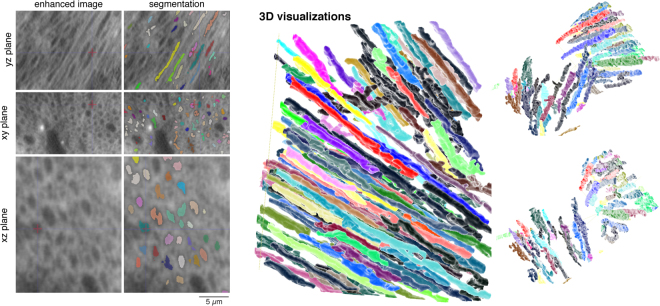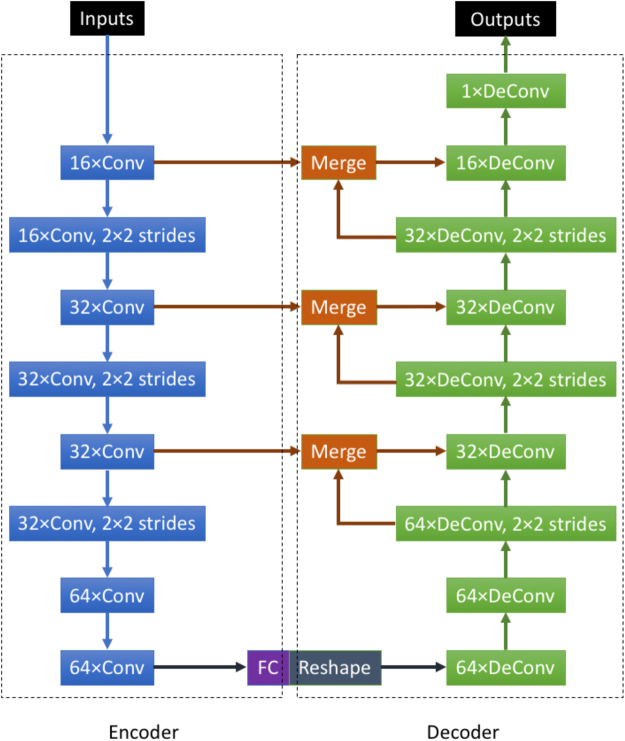Abstract
Synchrotron-based X-ray tomography offers the potential for rapid large-scale reconstructions of the interiors of materials and biological tissue at fine resolution. However, for radiation sensitive samples, there remain fundamental trade-offs between damaging samples during longer acquisition times and reducing signals with shorter acquisition times. We present a deep convolutional neural network (CNN) method that increases the acquired X-ray tomographic signal by at least a factor of 10 during low-dose fast acquisition by improving the quality of recorded projections. Short-exposure-time projections enhanced with CNNs show signal-to-noise ratios similar to long-exposure-time projections. They also show lower noise and more structural information than low-dose short-exposure acquisitions post-processed by other techniques. We evaluated this approach using simulated samples and further validated it with experimental data from radiation sensitive mouse brains acquired in a tomographic setting with transmission X-ray microscopy. We demonstrate that automated algorithms can reliably trace brain structures in low-dose datasets enhanced with CNN. This method can be applied to other tomographic or scanning based X-ray imaging techniques and has great potential for studying faster dynamics in specimens
Introduction
Beginning with the advent of X-ray computerized tomography (CT) for routine scanning back in the early 1970s1, X-ray CT has grown into a powerful imaging modality that can provide the internal three-dimensional (3D) morphology of representative volumes of biological tissues and material science specimens. With the use of appropriate X-ray optics for focusing the beam (e.g. zone-plates, capillaries, Kirkpatrick-Baez mirrors, etc.), reconstructing projections with tens of nanometers of spatial resolution is within reach. However, there is an inherent trade-off between signal-to-noise ratio (SNR) and beam damage when imaging at the nanoscale2 because the radiation dose absorbed by the sample scales inversely with the resolution3.
There are potential hardware and software solutions to compensate for beam damage induced by long-exposure acquisitions. Hardware solutions primarily include cryogenic cooling with integrated cryostages4–8. Inconveniently, such devices require operating under vacuum conditions and make it impossible to use high precision air-bearing rotary stages or to perform operando experiments using environmentally controlled cells to simulate real operational conditions (i.e., load, pressure, temperature, etc.). Moreover, even in cryogenic conditions, the amount of radiation dose deposited for resolving a 10 nm feature is estimated to be about 1010 Gray9, which is at the borderline of inducing irreversible damage for biological samples.
Computational solutions for improving low-dose CT data provide an alternative. Existing algorithmic approaches are essentially applied to the data after collection, either through denoising10,11, improving reconstruction algorithms12–16, or through other post-processing methods that are applied to the reconstructed images17–19. Because many of these approaches aim to denoise the data without knowledge of the structures of interest, they run the risk of either generating new artifacts in the data or losing structural information through post-processing. Thus, neither current hardware or software solutions provide a clear path to fast X-ray imaging of radiation sensitive samples at nanometer resolution.
A better approach is to enhance signals from low-dose projections during acquisition itself, avoiding the potential pitfalls described above. Deep learning methods, particularly convolutional deep neural networks (CNNs)20, are promising algorithmic approaches for addressing this issue. CNNs have been widely used for image denoising21–23, super-resolution microscopy24–27, and even post-hoc denoising of low-dose X-ray tomography reconstructions18. Despite their promise, CNNs have not yet been used to enhance acquisition data by learning corresponding ‘maps’ between features in low-dose and high-dose images of the same sample, and applying these learned maps to low-dose projections from the same sample. Since both the training and raw images are collected from the same dataset, it is unnecessary to estimate an additive noise model to correct the data.
In this article, we introduce a CNN-based approach for learning the mapping between a number of pairs of low-dose and high-dose projections. Using a limited number of high-dose training examples, we can then use the trained network to predict high-dose reconstructions from a full-rotation tomographic dataset with short-exposure times. The proposed approach can be applied to a range of low-dose tomography applications (e.g. lab-based CT systems); however, we test it using transmission x-ray microscopy (TXM)28. We applied the method to recover adult mouse brain structures (e.g. myelinated axon tracts) in 3D at nanometer length scales (∼50 nm) and successfully demonstrate that the CNN-based method can provide sufficient signal for automated tracing of individual axons. By combining computational imaging approaches with a multi-stage approach for tomography, we demonstrate that high-quality reconstructions can be obtained at a fraction of the radiation dose.
Results
Evaluation with synthetic data
To quantitatively evaluate improvements obtained using our CNN-based approach, we first created a synthetic dataset - a solid cube with 1000 sphere shaped particles randomly distributed throughout a 512 × 512 × 512 volume (see Fig. 1(a) for details). The synthetic dataset served as ground truth and allowed us to model different exposure conditions through adding noise to the data (e.g. shorter exposure times correspond to adding more noise). We generated 721 high-dose projections (P) from 0 to 180 degrees by applying a Radon transform to the object (Fig. 1(b)) and then added Gaussian noise (5% to 30%) to simulate low dose measurements at variable exposure time (Fig. 1(c)).
Figure 1.
The simulation data to evaluate the CNN algorithm performance: (a) the synthetic phantom for the simulation, the empty space, the cubic and the particles have the gray values of 0, 0.3 and 1 respectively. The particle diameters are 4 to 20 voxels; (b) one of the original high-quality projections from the synthetic phantom, P(0); (c) the projection with 5% artificial noise, Pn05. Result: (d) the enhanced projection by the CNN algorithm, Pe05(0) showing the background noise perfectly removed and structural information in good agreement with (b).
Using low- and high-dose pairs, we trained a CNN to estimate the high-resolution measurements (Po) when provided with low-dose projections (Pn). Specifically we trained the CNN using the projection pairs at 0° (Po(0) and Pn(0)) and 45° (Po(45) and Pn(45)) for all noise levels: (f: (Po(0), Po(45)) → (Pn(0), Pn(45))). To obtain a mean square error between the predicted projections and ground truth dataset of less than 10−4 (40 epochs), CNN training took about 2 hours (213 s × 40 epochs) with a Nvidia Quadro M5000 GPU. The trained CNN is used to process the full angle Pn to obtain the enhanced projections Pe. Our results on synthetic data demonstrate how our CNN-based approach is able to remove the background noise and clearly distinguish the structures of the particle phantoms (Fig. 1), which were smeared by the noise in the low-dose measurements. These improvements are even more significant for the projections with higher noise levels.
We performed tomographic reconstructions for Po, Pn and Pe to obtain the reconstructed 3D volumes Ro, Rn and Re. We evaluated the CNN improvements by comparing image quality metrics for these 3D volumes. We first gave a direct visualization of one slice and corresponding histograms for Ro, Rn and Re (Fig. 2). Then we plotted the histograms of each 3D dataset for Rn and Re (Fig. 3). At the last, we quantitatively compared Rn and Re with the ground truth by computing two popular criteria for quantifying image quality, the Peak Signal-to-Noise Ratio (PSNR) and Structural Similarity Index (SSIM)29 of Rn/Ro and Re/Ro (Fig. 4).
Figure 2.
Reconstructed slice (left) and corresponding histograms (right). The top row is a slice of the ground truth reconstruction (Ro); the middle row is the same reconstructed slice (Rn05) from the projections with 5% noise (Pn05); the bottom row is the same reconstructed slice (Re05) from the CNN enhanced projections (Pe05). ‘A’, ‘B’ and ‘C’, correspond to the black region outside the object, the gray region inside the object and the white particles.
Figure 3.
The histograms of the full 3D (512 slices) reconstructed datasets (Rn and Re) obtained from the noisy (Pn) and from the CNN enhanced projections (Pe).
Figure 4.
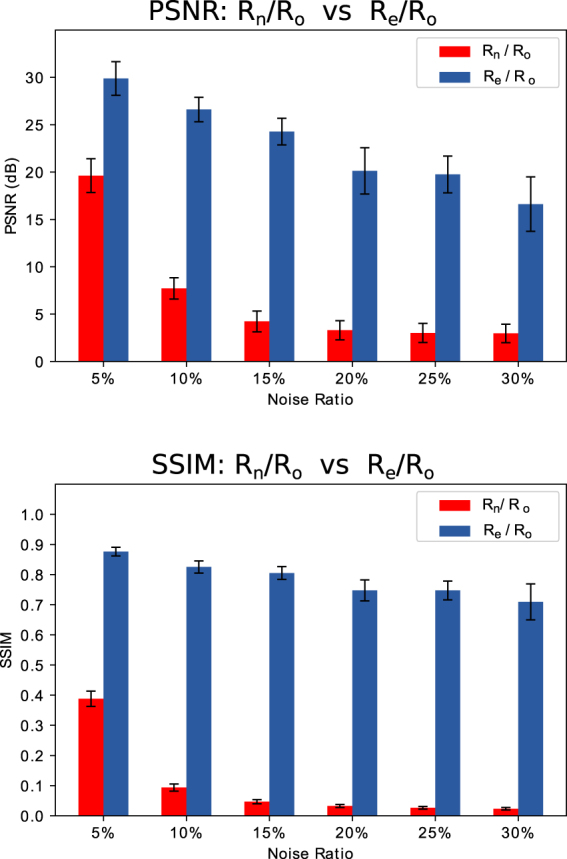
Quantitative comparison between reconstructions (Rn and Re) obtained from noisy and enhanced projections with the ground truth using Peak signal-to-noise ratio (PSNR) and Structural Similarity Index (SSIM). PSNR and SSIM are computed from the full 3D reconstructed datasets (512 slices). The higher value of PSNR and SSIM means better similarity of the compared images. The maximum value of SSIM is 1.
As shown in Fig. 2 (right), the image quality of Re is visually close to Ro. The corresponding histograms also proved it, see Fig. 2 (left). Compared with the ground truth (Ro(20)), Rn(20) shows strong noise and the three phases (A: black space; B: gray solid cubic; C: white particles) smeared in the histogram. The histogram of Re05(20) shows almost the same pattern as of Ro(20). After the CNN enhancement of the noisy projections, the reconstruction quality is close to the ground truth.
The histograms of the 3D datasets Rn and Re show significant improvements by the CNN enhancement for all the noise levels of our simulations, see Fig. 3. When the noise level is ≥10%, the histograms of Rn only show a single peak making segmentation by simple thresholding impossible. The histograms of Re show three distinguished peaks when noise level ≤20%, and two distinguished peaks for the rest. This confirms that the CNN enhanced projections produce the reconstructions with better quality, thus making it possible to distinguish the different phases by simply thresholding.
Figure 4 shows the means and standard deviations of the PSNR and SSIM for each 3D volume. The PSNR and SSIM of Rn/Ro and Re/Ro are displayed as red and blue bars, respectively. Our results demonstrate that the PSNR of Re/Ro is always much higher than Rn/Ro. This shows that the image quality of Re is much closer to the ground truth Ro than Rn. As the noise level increases, the improvements of Re over Rn are more significant. The SSIM shows similar behavior, with even larger differences between Re/Ro and Rn/Ro than observed in the PSNR. Even for the extreme noise situation (30%), the CNN can still recover enough signal to produce results with acceptable metrics (PSNR: 2.96 → 16.61, SSIM: 0.02 → 0.71). Our evaluations demonstrate that our CNN-based method produced tomographic reconstructions with consistently better quality, both in terms of their structural information and in their accuracy, even in extremely noisy situations.
Validation on a mouse brain sample
The proposed method was further validated on a small sample of mouse somatosensory (S1) cortex containing myelinated axons. This sample has been stained with lead using a standard ROTO procedure30 to increase X-ray absorption contrast in the projections. After staining, the sample was embedded in plastic (EPON) to make it more X-ray resistant. After preparing the sample, it was measured with nano-CT using the TXM instrument at the 32-ID beamline of the Advanced Photon Source (APS) at Argonne National Laboratory. We first scanned the sample with 30 s exposure time (high-dose) only for 6 angles (0° to 150°, 30° per projection). We then performed a full tomographic scan (361 projections for 0° to 180°) of the sample with 2 s exposure time (low-dose) per projection. All the projections were acquired with 2k × 2k resolution and a pixel size of 30 nm. These projections were then down-sampled to 1k × 1k for subsequent processing and analysis (60 nm pixel size). The resulting reconstructions from low-dose projections mitigate beam damage, but provide limited contrast needed to resolve the width of myelin in the images.
We used the short-exposure and long-exposure projections pairs of 30° and 120° to train our CNN approach (f: (P2(30), P2(120)) → (P30(30), P30(120))). The trained CNN was then used to enhance all of the 361 low-dose projections. We evaluated the improvements of CNN-enhanced projections Pe by computing the PSNR and SSIM for Pe/P30 and P2/P30, as shown in Table 1. The SSIM values of Pe/P30 are much higher than the SSIM values of P2/P30. The SSIM values after CNN enhancement are about 0.9. Effectively, the CNN makes the image quality of 2 s exposure projections P2 almost equivalent to the 30 s exposure projections P30. The PSNR values also reflect higher image quality with Pe/P30 higher than P2/P30 across the board.
Table 1.
Comparisons of the 2 s projections and the CNN enhanced projections with 30 s projections.
| Angles (degree) | SSIM | PSNR(dB) | ||
|---|---|---|---|---|
| P2/P30 | Pe/P30 | P2/P30 | Pe/P30 | |
| 0 (validating) | 0.655 | 0.897 | 22.302 | 24.377 |
| 30 (training) | 0.768 | 0.937 | 25.124 | 31.828 |
| 60 (validating) | 0.720 | 0.938 | 27.381 | 34.568 |
| 90 (validating) | 0.518 | 0.892 | 14.900 | 18.282 |
| 120 (training) | 0.415 | 0.853 | 15.439 | 18.320 |
| 150 (validating) | 0.464 | 0.848 | 12.889 | 25.414 |
We compared the details of the image quality between Pe(90)/P30(90) and P2(90)/P30(90), shown in Fig. 5. The profiles of CNN-enhanced projection show greater overlap to the 30 s projection and much less noise than the 2 s projection. This confirms that our method provides good enhancement in both the horizontal and vertical planes of our projection images, thus providing isotropic enhancement and noise removal. When comparing the SSIM map of the 2 s projection with the 30 s projection, the majority of SSIM values range from 0.4 to 0.6; a small part near the bottom of the sample produces very small SSIM values (∼0.2). The bottom right of Fig. 5 shows the SSIM map of the CNN-enhanced projection compared with the 30 s projection. The SSIM values of the whole map are about 0.9. Most parts of the sample region have a SSIM value almost at 1. These results show dramatic improvement in the image quality by enhancing the low-dose projections with our CNN-based approach.
Figure 5.
An example of the mouse brain projections with 2 s exposure time, 30 s exposure time and the enhanced projection with CNN. The top left image is the projection with 30 s exposure time at 90°. The top right are the profiles of the projections with 2 s (gray line), 30 s (blue line) exposure time, and the 2 s projection enhanced with CNN (red line). The profiles locations are as the yellow lines of the top left image. The maps of the bottom are the SSIM maps of P2(90)/P30(90) and Pe(90)/P30(90).
We also compared the CNN method with median filter and total variation regularization (TV)31,32, shown in Fig. 6. The SSIM values of Pe/P30 is higher than Pmed/P30 and Ptv/P30, where Pmed and Ptv denote the projections denoised with median filter and TV regularization respectively. The CNN enhancement performs the best to recover the structural information from the noisy projection.
Figure 6.
Comparing the CNN projection enhancement algorithm with the traditional denoising algorithms. The top left image is the projection with 30 s exposure time at 0°. The top right is the SSIM map between the 2 s projection denoised with median filter and the 30 s projection Pmed(0)/P30(0). The bottom left is the SSIM map between the 2 s projection denoised with tv filter and the 30 s projection Ptv(0)/P30(0). The bottom right is the SSIM map between the CNN enhanced projection and the 30 s projection Pe(0)/P30(0).
We performed tomographic reconstructions for Pe, P2, Pmed and Ptv to obtain Re, R2, Rmed and Rtv respectively. As shown in Fig. 7, the slice of Re reveals structures that are barely visible in R2. The CNN enhancement improves the reconstruction quality for the low-dose data. On the other hand, Rmed is rather noisy and Rtv is too blurry to extract the structure of the axons.
Figure 7.
An example of the reconstructions from different quality of the projections of the mouse brain sample. The top row is a slice that reconstructed from the CNN enhanced projections. The four small images in the middle rows are different reconstructions for the section of the blue-dash rectangular window above. They are the reconstructions from the projections with 2 s exposure, the projections enhanced with CNN, the projections denoised with median filter and TV respectively. The plots in the bottom row are the profiles taken from the dash lines of the four small images.
In the CNN-enhanced volume Re, axons can be automatically traced over the extent of the entire sample using methods previously developed for segmenting micro-CT data33. The width of myelin can also be estimated in the enhanced data, as shown in Fig. 8. After enhancement, low-dose measurements can be used to estimate the thickness of myelin around the axons in the sample. In addition, tracing and resolving 2D cross-sections of axons is also improved in the CNN-enhanced images (as confirmed through manual annotations of both volumes).
Figure 8.
CNN-based enhancement enables automated segmentation of myelinated axons in mouse somatosensory cortex
Discussion
We have introduced a new CNN-based method that dramatically reduces the exposure time by a factor of 10 for synchrotron-source X-ray tomography, while retaining structural information. Reducing imaging time decreases sample damage and provides more accurate reconstructions of the interiors of materials and biological samples. We applied this algorithm to both synthetic datasets and reconstructions of the white matter of mammalian brain samples.
As the evaluation of our CNN approach with the synthetic datasets demonstrates, the CNN does not simply ‘denoise’ the noisy projections. It also learns to distinguish the structural information of the object from the noise. The traditional denoising algorithms always lose spatial resolution if the noise is strong. However, the CNN directly learned the mapping between the noisy images and high-quality images. It can keep the resolution close to the high-quality images of learning data, when processing the tests images. The CNN processed images can be easily segmented.
Using the CNN to enhance the tomographic projections, instead of denoising the final reconstructed images18, was presumed to have great advantages. The tests with both the synthetic datasets and the real TXM measurements both confirmed our supposition. The CNN successfully reduces noise, and also makes the low-dose projections show structural information as well as a high-dose projection would. We also presumed fewer training images were required when the data is from the measurement of the same object as the testing data. The local features of different tomographic projections for the same object have great similarity. Despite the small size of the training datasets, they included necessary features to enhance the full-scanning projections. Thus, the accuracy of the predictions based on this training model is ensured. All our tests also proved that.
In our application of this method on a brain sample, we found that even at the low-dose that we used to obtain the results, we still observed some beam damage. Thus, at this limit, it is impossible to increase the dose further without considerable degradation. This suggests that only computational approaches can be used to improve image quality in these settings. It is only after CNN enhancement that axons could be resolved at levels sufficient to measure the thickness of myelin at high rates across the volume. Our approach for computational imaging-based enhancement promises high-resolution and dynamic imaging of brains in the future and can be combined with micro-CT approaches that capture mesoscale neuroanatomy33.
The running time of our CNN approach can be easily parallelized and scaled up to GPU clusters. We have tested it on the GPU cluster of Cooley from Argonne Leadership Computing Facility (ALCF). With 48 Tesla K80 dual-GPU nodes, the computing time of the data enhancement procedure can be reduced to less than 10 minutes for most of the tomographic scanning with 2 K resolution. Even including the data processing time, the whole measurement will be faster.
In addition to the good performance obtained through enhancing the low-dose tomographic projections, our CNN approach also has great potential for dynamic measurements of X-ray imaging. It speeds up the measurement process by the magnitude of 10 with keeping the data quality close to the long-time scanning. The same principle can also be applied to other X-ray imaging techniques, such as X-ray fluorescence and X-ray ptychography, to reduce dose damage or scanning time.
Methods
Overview of approach
Tomographic reconstructions from short-exposure X-ray images yield noisy images as too few photons are received by the sensor. The signal to noise ratio decreases as photon counts drop and the structural information about the object cannot be reconstructed successfully unless regularization methods or denoising methods are used.
Although, the features in X-ray projections of the same object for different exposure times are correlated to some extent, there is no relation readily available. This is due to the complexity of the features in the sample and variations in noise between exposure times. We used a deep CNN to learn image-to-image transformations among projections according to the rule established in the training data sets. The basic idea is based on learning a “transformation” between images taken at short (Is) and long (Il) exposures. The learning is done by minimizing the corresponding cost function,
| 1 |
With this basic principle, we built a CNN architecture to enhance tomographic data with short-exposure times.
CNN architecture
The proposed CNN architecture was inspired by various image transformation models in literature27,34. The input and output of the network are both images, instead of images as inputs and scalar labels as outputs for the typical CNN model35. As shown in Fig. 9, the network architecture consists of two principal parts: the image encoder and the data decoder. The image encoder is composed of 8 convolutional layers and a fully connected layer. All convolutional layers use 3 × 3 convolution kernels. We increase the number of convolution kernels for each layer from 16 to 64. Three of the convolutional layers use a 2 × 2 strides to compute the convolution from every 2 pixels of the corresponding images36. This reduces the image width and height by half after the convolution. The convolutional layers with and without strides extract multiple features of the input images (W × H) from different scales (W × H to W/8 × H/8). Together with the fully connected layer, the network enforces image information to be sparse with various feature maps. The encoder aims to fit the image information with specific target data.
Figure 9.
Image transformation model of CNN. “Conv” is the abbreviation of convolution kernel. “DeConv” is the abbreviation of deconvolution kernel. The numbers before the “Conv” or “DeConv” are the numbers of kernels. “FC” is the abbreviation of fully connected layer. All the convolutional and deconvolutional layers use 3 × 3 kernels. All the layers use Relu as the activation functions43.
The second half of the network is the decoder. The encoded data are reshaped to a new image size of (W/8 × H/8). We use 9 deconvolutional layers37, which are also called transpose convolutional layers. All deconvolutional layers use 3 × 3 deconvolution kernels. We decrease the number of deconvolution kernels for each layer from 64 to 1. Three of the deconvolutional layers use the 2 × 2 strides, which double the image width and height. These decovolutional with and without strides generate layers of feature maps with different scales. At the end, we use a deconvolutional layer only with one deconvolutional kernel to generate a single output image that matches the target image. Using the deconvolutional layers as the decoder has a fundamental advantage of keeping the image with good resolution. This avoids smoothing the patterns and boundaries of structures by using convolutional layers. The main reason is that the convolutional layers compute the pixels of the new image from each of their 3 × 3 neighbors. Deconvolution is the inverse of this process and can make the output images as sharp as the input images.
Using merge layers is another important way of making the output images sharp. In the decoder part of the network, feature maps generated from the deconvolutional layers are concatenated with the preceding feature maps of the same scale from the encoder part. The proportions of the merged feature maps from different layers are decided by the kernel number of these layers, see Fig. 9. With these merged layers, the feature maps of the decoder part include the features with different resolutions of the input images, including the original resolution of the input images. They can avoid the resolution loss during the down-sampling process of the encoder.
The objective function of the CNN is computed based on the peak signal-to-noise ratio (PSNR):
| 2 |
The PSNR can be calculated as:
| 3 |
where Imax is the possible maximum pixel value, MSE is the mean square error, and f(Is) is the new image generated by the CNN.
Normalization and patch extraction
To infer high fidelity reconstructions from short-exposure tomographic measurements, we trained a deep CNN to learn the mapping between the two conditions. To prepare the training data, we first scanned the object for a few angles for obtaining images taken at relatively long-exposure times (Il). Then, we performed full-angle tomographic scanning to obtain projections with shorter exposure times (Is). We used the long-exposure time projection and its related short-exposure time projection as the training data to fit the CNN:
| 4 |
where Is(a) and Il(a) are the projections of angle a. Normally, two or three angles of projections are enough for training.
We processed the training data in two steps before tomographic reconstruction: normalization and patches extraction. The normalization was done in two steps: and . We extracted overlapped small patches from these normalized images as the final training inputs and outputs using the same approach described in35.
The reason and benefit to use the small patches are as following:
Every projection of the same object shows different patterns. We only had one angle view of the image and this was not sufficient to predict all the projections. However, if we extracted small patches from the projections, we could usually find very similar local features from these patches. Thus, the patches from one projection include enough local features to train the network and to predict the rest of the projections.
The overlapped patches increase the number of the training data from a few projection images to ∼105 of small images. The distances between the data points become smaller than directly using the full images. This can significantly reduce the probability of overfitting.
After we trained the CNN transformation model, we can save the fitted weights of the network to predict projections with quality close to that of the long-time projections (Il) from the short-exposure-time projections (Is). Small patches with the same size as the training data were extracted from these projections (Is) and used as the input for the trained CNN. We reconstructed these patches to obtain enhanced projections. These enhanced projections were used for the tomographic reconstruction to get the final result.
Tomographic acquisition and reconstruction
The synthetic projections were generated from the simulated phantoms with Radon transform38, which is an integral transform whose inverse is used to reconstruct images from X-ray CT scans. The experimental dataset was collected at the Transmission X-ray Microscope (TXM) of sector 32-ID at the Advanced Photon Source2 and formatted in Scientific Data Exchange standard39. We performed tomographic reconstruction with the open-source TomoPy toolbox31 using the CNN enhanced short-exposure projections and the long-exposure projections. We applied a Fourier grid algorithm (GridRec) with a Parzen filter for reconstruction40, because of its good balance of the reconstruction speed and accuracy, however other tomographic reconstruction methods can as well be used.
Axonal segmentation
After reconstructing images of a small mouse brain sample, we applied segmentation methods previously used to segment blood vessels and cell bodies in micro-CT data33 to segment myelinated axons in the sample. To do this, we first trained a random forest classifier using an interactive tool for segmentation called ilastik41 using a combination of edge, texture, and intensity-based 3D features. Following training, we applied the classifier to a small reconstructed image volume from a cube of mouse cortex (234 × 400 × 300). We then thresholded the classifier probability estimates (threshold = 0.92) and applied 3D morphological filtering operations to the resulting thresholded data (see33 for more details). Finally, we visualized the segmented data using the multi-view projection and 3D visualization tool in ITK-Snap42.
Acknowledgements
This research used resources of the Advanced Photon Source, a U.S. Department of Energy (DOE) Office of Science User Facility operated for the DOE Office of Science by Argonne National Laboratory under Contract No. DE-AC02-06CH11357. This research also used resources of the Argonne Leadership Computing Facility, which is a DOE Office of Science User Facility supported under Contract DE-AC02-06CH11357.
Author Contributions
X.Y. developed the algorithm, implemented the simulations, processed the experimental data and analyzed the results. V.D.A. conducted all the nano-CT measurements. F.D.C. and D.G. assisted the data analysis. W.S. scaled up the CNN approach for running on GPU cluster. N.K. provided the mouse brain sample. E.L.D. implemented the segmentation and 3D rendering of the brain data. All the authors reviewed the manuscript.
Competing Interests
The authors declare no competing interests.
Footnotes
Publisher's note: Springer Nature remains neutral with regard to jurisdictional claims in published maps and institutional affiliations.
References
- 1.Hounsfield GN. Computerized transverse axial scanning (tomography): Part 1. description of system. The British Journal of Radiology. 1973;46:1016–1022. doi: 10.1259/0007-1285-46-552-1016. [DOI] [PubMed] [Google Scholar]
- 2.De Andrade, V. et al. Nanoscale 3d imaging at the advanced photon source. SPIE Newsroom (2016).
- 3.Goldman LW. Principles of ct: Radiation dose and image quality. Journal of Nuclear Medicine Technology. 2007;35:213–225. doi: 10.2967/jnmt.106.037846. [DOI] [PubMed] [Google Scholar]
- 4.Zhang X, Jacobsen C, Lindaas S, Williams S. Exposure strategies for polymethyl methacrylate from in-situ x-ray-absorption near-edge structure spectroscopy. Journal of Vacuum Science & Technology B. 1995;13:1477–1483. doi: 10.1116/1.588175. [DOI] [Google Scholar]
- 5.Maser J, et al. Soft x-ray microscopy with a cryo scanning transmission x-ray microscope: I. instrumentation, imaging and spectroscopy. Journal of Microscopy-Oxford. 2000;197:68–79. doi: 10.1046/j.1365-2818.2000.00630.x. [DOI] [PubMed] [Google Scholar]
- 6.Salome, M. et al. The ID21 Scanning X-ray Microscope at ESRF, vol. 425 of Journal of Physics Conference Series (Iop Publishing Ltd, Bristol, 2013).
- 7.Cotte M, et al. The id21 x-ray and infrared microscopy beamline at the esrf: status and recent applications to artistic materials. Journal of Analytical Atomic Spectrometry. 2017;32:477–493. doi: 10.1039/C6JA00356G. [DOI] [Google Scholar]
- 8.Chen S, et al. The bionanoprobe: hard x-ray fluorescence nanoprobe with cryogenic capabilities. Journal of Synchrotron Radiation. 2014;21:66–75. doi: 10.1107/S1600577513029676. [DOI] [PMC free article] [PubMed] [Google Scholar]
- 9.Howells M, et al. An assessment of the resolution limitation due to radiation-damage in x-ray diffraction microscopy. Journal of Electron Spectroscopy and Related Phenomena. 2009;170:4–12. doi: 10.1016/j.elspec.2008.10.008. [DOI] [PMC free article] [PubMed] [Google Scholar]
- 10.Manduca A, et al. Projection space denoising with bilateral filtering and ct noise modeling for dose reduction in ct. Med Phys. 2009;36:4911–9. doi: 10.1118/1.3232004. [DOI] [PMC free article] [PubMed] [Google Scholar]
- 11.Maier A, et al. Three-dimensional anisotropic adaptive filtering of projection data for noise reduction in cone beam ct. Med Phys. 2011;38:5896–909. doi: 10.1118/1.3633901. [DOI] [PMC free article] [PubMed] [Google Scholar]
- 12.Han XA, et al. Algorithm-enabled low-dose micro-ct imaging. Ieee Transactions on Medical Imaging. 2011;30:606–620. doi: 10.1109/TMI.2010.2089695. [DOI] [PMC free article] [PubMed] [Google Scholar]
- 13.Pelt DM, Batenburg KJ. Fast tomographic reconstruction from limited data using artificial neural networks. IEEE Transactions on Image Processing. 2013;22:5238–5251. doi: 10.1109/TIP.2013.2283142. [DOI] [PubMed] [Google Scholar]
- 14.Zhang HY, Zhang LY, Sun YS, Zhang JY, Chen L. Low dose ct image statistical iterative reconstruction algorithms based on off-line dictionary sparse representation. Optik. 2017;131:785–797. doi: 10.1016/j.ijleo.2016.11.186. [DOI] [Google Scholar]
- 15.Mirone A, Brun E, Coan P. A dictionary learning approach with overlap for the low dose computed tomography reconstruction and its vectorial application to differential phase tomography. PLOS ONE. 2014;9:e114325. doi: 10.1371/journal.pone.0114325. [DOI] [PMC free article] [PubMed] [Google Scholar]
- 16.Zhao Y, et al. High-resolution, low-dose phase contrast x-ray tomography for 3d diagnosis of human breast cancers. Proceedings of the National Academy of Sciences. 2012;109:18290–18294. doi: 10.1073/pnas.1204460109. [DOI] [PMC free article] [PubMed] [Google Scholar]
- 17.Zhu YN, Zhao ML, Zhao YS, Li HW, Zhang P. Noise reduction with low dose ct data based on a modified rof model. Optics Express. 2012;20:17987–18004. doi: 10.1364/OE.20.017987. [DOI] [PubMed] [Google Scholar]
- 18.Chen H, et al. Low-dose ct via convolutional neural network. Biomedical Optics Express. 2017;8:679–694. doi: 10.1364/BOE.8.000679. [DOI] [PMC free article] [PubMed] [Google Scholar]
- 19.Zhang H, et al. Applications of nonlocal means algorithm in low-dose x-ray ct image processing and reconstruction: A review. Medical Physics. 2017;44:1168–1185. doi: 10.1002/mp.12097. [DOI] [PMC free article] [PubMed] [Google Scholar]
- 20.LeCun Y, Bengio Y, Hinton G. Deep learning. Nature. 2015;521:436–444. doi: 10.1038/nature14539. [DOI] [PubMed] [Google Scholar]
- 21.Wang, X. J. et al. Deep Convolutional Architecture for Natural Image Denoising. International Conference on Wireless Communications and Signal Processing (2015).
- 22.Xu, Q. Y., Zhang, C. J. & Zhang, L. Denoising convolutional neural network. 2015 IEEE International Conference on Information and Automation 1184–1187 (2015).
- 23.Koziarski, M. & Cyganek, B. Deep Neural Image Denoising, vol. 9972 of Lecture Notes in Computer Science, 163–173 (Springer Int Publishing Ag, Cham, 2016).
- 24.Chua, K. K. & Tay, Y. H. Enhanced Image Super-Resolution Technique Using Convolutional Neural Network, vol. 8237 of Lecture Notes in Computer Science, 157–164 (2013).
- 25.Osendorfer, C., Soyer, H. & van der Smagt, P. Image Super-Resolution with Fast Approximate Convolutional Sparse Coding, vol. 8836 of Lecture Notes in Computer Science, 250–257 (2014).
- 26.Liang YD, Wang JJ, Zhou SP, Gong YH, Zheng NN. Incorporating image priors with deep convolutional neural networks for image super-resolution. Neurocomputing. 2016;194:340–347. doi: 10.1016/j.neucom.2016.02.046. [DOI] [Google Scholar]
- 27.Dong C, Loy CC, He K, Tang X. Image super-resolution using deep convolutional networks. IEEE Transactions on Pattern Analysis and Machine Intelligence. 2016;38:295–307. doi: 10.1109/TPAMI.2015.2439281. [DOI] [PubMed] [Google Scholar]
- 28.De Andrade V, et al. A new transmission x-ray microscope for in-situ nano-tomography at the aps. 2016;9967:9967–9967–1. [Google Scholar]
- 29.Wang Z, Bovik AC, Sheikh HR, Simoncelli EP. Image quality assessment: from error visibility to structural similarity. IEEE Transactions on Image Processing. 2004;13:600–612. doi: 10.1109/TIP.2003.819861. [DOI] [PubMed] [Google Scholar]
- 30.Tapia JC, et al. High-contrast en bloc staining of neuronal tissue for field emission scanning electron microscopy. Nature protocols. 2012;7:193–206. doi: 10.1038/nprot.2011.439. [DOI] [PMC free article] [PubMed] [Google Scholar]
- 31.Gürsoy D, De Carlo F, Xiao X, Jacobsen C. Tomopy: a framework for the analysis of synchrotrontomographic data. Journal of Synchrotron Radiation. 2014;21:1188–1193. doi: 10.1107/S1600577514013939. [DOI] [PMC free article] [PubMed] [Google Scholar]
- 32.Chambolle A. An algorithm for total variation minimization and applications. Journal of Mathematical Imaging and Vision. 2004;20:89–97. doi: 10.1023/B:JMIV.0000011320.81911.38. [DOI] [Google Scholar]
- 33.Dyer, E. L. et al. Quantifying mesoscale neuroanatomy using x-ray microtomography. arXiv preprint arXiv:1604.03629 (2016). [DOI] [PMC free article] [PubMed]
- 34.Ronneberger, O., Fischer, P. & Brox, T. U-Net: Convolutional Networks for Biomedical Image Segmentation, vol. 9351 of Lecture Notes in Computer Science, 234–241 (Springer Int Publishing Ag, Cham, 2015).
- 35.Yang XG, De Carlo F, Phatak C, Gursoy D. A convolutional neural network approach to calibrating the rotation axis for x-ray computed tomography. Journal of Synchrotron Radiation. 2017;24:469–475. doi: 10.1107/S1600577516020117. [DOI] [PubMed] [Google Scholar]
- 36.Liu ZY, Gao JF, Yang GG, Zhang H, He Y. Localization and classification of paddy field pests using a saliency map and deep convolutional neural network. Scientific Reports. 2016;6:12. doi: 10.1038/s41598-016-0010-7. [DOI] [PMC free article] [PubMed] [Google Scholar]
- 37.Zeiler, M. D., Krishnan, D., Taylor, G. W. & Fergus, R. Deconvolutional networks. In 2010 IEEE Computer Society Conference on Computer Vision and Pattern Recognition, 2528–2535 (2010). 10.1109/CVPR.2010.5539957.
- 38.Radon J. On the determination of functions from their integral values along certain manifolds. IEEE Transactions on Medical Imaging. 1986;5:170–176. doi: 10.1109/TMI.1986.4307775. [DOI] [PubMed] [Google Scholar]
- 39.De Carlo F, et al. Scientific data exchange: a schema for HDF5-based storage of raw and analyzed data. Journal of Synchrotron Radiation. 2014;21:1224–1230. doi: 10.1107/S160057751401604X. [DOI] [PubMed] [Google Scholar]
- 40.Dowd BA, et al. Developments in synchrotron x-ray computed microtomography at the national synchrotron light source. Developments in X-Ray Tomography II. 1999;3772:224–236. doi: 10.1117/12.363725. [DOI] [Google Scholar]
- 41.Sommer, C., Straehle, C., Koethe, U. & Hamprecht, F. A. Ilastik: Interactive learning and segmentation toolkit. In Biomedical Imaging: From Nano to Macro, 2011 IEEE International Symposium on, 230–233 (IEEE, 2011).
- 42.Yushkevich PA, et al. User-guided 3d active contour segmentation of anatomical structures: significantly improved efficiency and reliability. Neuroimage. 2006;31:1116–1128. doi: 10.1016/j.neuroimage.2006.01.015. [DOI] [PubMed] [Google Scholar]
- 43.Dahl, G. E., Sainath, T. N. & Hinton, G. E. Improving deep neural networks for lvcsr using rectified linear units and dropout. In IEEE International Conference on Acoustics, Speech and Signal Processing, 8609–8613 (2013). 10.1109/ICASSP.2013.6639346.



